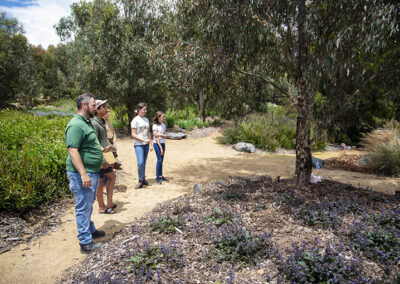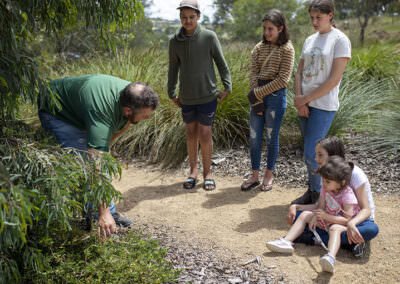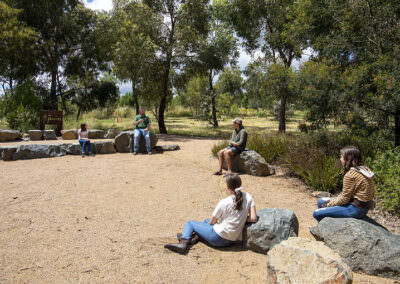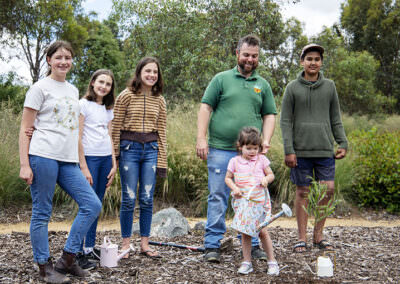
Creating an Indigenous plant-use garden: vision
Time Allocation: 40 minutes*
Activity Level: Complex
Introduction
Planning this garden starts a journey of understanding of Aboriginal and Torres Strait Islander culture and histories, and towards reconciliation. It is a wonderful opportunity to create a space to pay respect to the First Nations peoples of Australia and their extensive knowledge of the plants that grow naturally in the Australian landscape. The garden you will create will be a space that educates not only your group, but many children and adults for a long time to come.
Your vision, and collaborative and consultative planning is an important part of this project. Growing your garden will grow your understanding and strengthen your relationships with First Nations peoples.
Checklist
Instructions
 STEP 1
STEP 1
Begin this activity at your location with an Acknowledgement of Country. By acknowledging the Land, you are also making a promise that you will care for the Land, the waterways, the plants and the animals.
A vision will guide the decisions needed in creating your Indigenous plant-use garden.
Discuss the 5 main elements to consider when developing the vision for your garden:
- How are you going to connect to Aboriginal and Torres Strait Islander people and cultures?
- How are you going to connect to your garden space and the environment?
- How is your garden contributing to the biodiversity of the area?
- How are you going to use the plants?
- How will you care for your garden?
Use the activity sheet to help the children record their learnings.
 STEP 2
STEP 2
Creating an Indigenous plant-use garden is an important opportunity to build relationships with your local First Nations community. This is an important aspect of reconciliation.
Consulting with your local Elders and First Nations community is essential to build relationships. This is important throughout the whole process. This is a good opportunity to invite an Elder to speak at your school or to your group.
You may also like to reach out or find contacts in your local First Nations community. You could speak to parents of First Nations students, speak to the Indigenous Learning Officer at your school, your local Land Council or Landcare group.
Alternatively use The AIATSIS Map of Indigenous Australia interactive map.
 STEP 3
STEP 3
Consider engaging a First Nations peoples artist or Aboriginal and Torres Strait Islander owned business (such as nurseries, landscapers and garden designers) to be part of your project, a great place to source your plants and to help out with knowledge about how to grow and use them.
There are many elements other than plants that you may like to include.
- Commission a local First Nations artist to work with you to create a cultural art piece or instillation.
- Create a Yarning Circle to meet and yarn.
- Work with local Elders to develop signs that include appropriate plant use information.
- Design your garden to include important elements for the local First Nations peoples group. This may include story poles, stepping stones and natural sculptures of animals.
If you are interested in using an Aboriginal or Torres Strait Islander name or word, story, or artwork, it’s important to request permission and consult with your local Traditional Owners. Refer to the Educator notes for more information.
 STEP 4
STEP 4
Connection to the Land (Country) is very important for First Nations peoples.
Consider how you are going to connect to your new space. Think about the different ways that you can use the space. Is it going to be a place of learning, reflecting, quiet, enjoyment? How will it help your physical health as well as your mental health?
Consider how other people may use the space. What will be the benefits of the garden to you and other people?
This garden will help support biodiversity because it will provide a space for plants and animals that would naturally live in your area.
What are some of the animals that you may see come back into this space?
Extension Activity
Extension 1
Once you have completed your vision think about how you can share your vision and encourage others to be part of creating a plant-use garden. This can be part of your invitation for local First Nations peoples and community to be part of the project. Design an invitation, poster or story for your newsletter or a social media post so others can be inspired to get involved.
Extension 2
What skills or knowledge do you already have to create an Aboriginal and Torres Strait Islander plant-use garden? Maybe you learned from your own Elders or from previous involvement in such activities and would like to share information? Are there other skills that you need from people in your community particularly First Nations peoples knowledge holders and Elders. Where can you find out more?